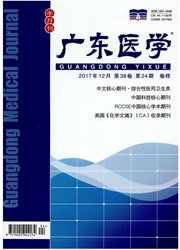

 中文摘要:
中文摘要:
目的探讨急性重症肝炎小鼠肝脏趋化因子IP-10 mRNA的表达及意义。方法通过腹腔注射3型鼠肝炎病毒(MHV-3)建立急性重症肝炎小鼠模型,常规HE染色后进行肝组织HAI积分评估,常规生化检测感染后各时间点血清ALT的水平,实时定量PCR技术检测感染MHV-3 0、24、48、72 h后的Babl/cJ小鼠肝内趋化因子IP-10 mRNA的表达水平。结果感染后的Balb/cJ小鼠血清ALT的水平以及肝脏HAI积分均显著升高,肝内IP-10 mRNA水平也显著上升,在48和72 h分别为感染前的99和150倍。Pearson相关分析证实感染后肝内趋化因子IP-10 mRNA的表达与血清ALT及肝组织HAI积分显著正相关(P〈0.05)。结论趋化因子IP-10在小鼠急性重症肝炎肝内淋巴细胞的募集及随后的坏死性炎症和急性肝衰竭中可能发挥着重要作用。
 英文摘要:
英文摘要:
Objective To investigate the significance of hepatic chemokine IP-10 mRNA expression in mice with fulminant hepatitis.Methods Mouse model of fulimnant hepatitis was established by intraperitoneal injection with 100 PFU mouse hepatitis virus-3(MHV-3).The pathological changes of live tissue were examined by HE staining for evaluation of HAI scores,and serum ALT levels were measured.The hepatic mRNA level of chemokines IP-10 was quantified by real-time PCR.Results Significant elevation of serum ALT,HAI scores and hepatic IP-10 mRNA levels were observed after infection.Compared with that in controls,the hepatic mRNA level of IP-10 increased by 99 and 150 folds at 48 and 72 h after infection,respectively.Expression of hepatic IP-10 mRNA was significantly positively correlated with serum ALT and HAI scores according to Pearson's correlation analysis(P0.05).Conclusion Chemokine IP-10 may play a key role in the recruitment of intrahepatic lymphocytes and the subsequent necrotic inflammation and hepatic failure in MHV-3 infection.
 同期刊论文项目
同期刊论文项目
 同项目期刊论文
同项目期刊论文
 Relapse rate and associated - factor of recurrence after stopping NUCs therapy with different prolon
Relapse rate and associated - factor of recurrence after stopping NUCs therapy with different prolon Impaired phosphate and tension homologue deleted on chromosome 10 expression and its prognostic role
Impaired phosphate and tension homologue deleted on chromosome 10 expression and its prognostic role 期刊信息
期刊信息
